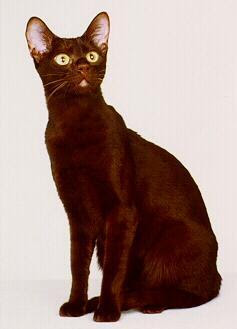The Havana lives up to its name not only because its rich, brown coat resembles the colour of the expensive cigar tobacco, but also because it has the elegance, refined manners, and distinctive history that reeks of exclusivity.
History
During the 1950s in Great Britain a Seal-point Siamese crossed to a black shorthaired cat of Siamese ancestry formed the foundation of the breed, which was recognized in 1958. The British breeding program continued to use Siamese outcrosses, but American breeders decided to prohibit the use of Siamese, preferring the look of the original imports, was less Oriental in type, and which they called the Havana Brown.
Temperament
The Havana is an active, affectionate, and highly intelligent cat.
Varieties
There is one colour variety, the Frost, which is exclusive to the US, where also the breed is judged by a different standard to the British. The American Havana Brown is a more sturdy cat, with a medium-length torso, a rounder face, oval eyes, rounded-tipped ears, and longer fur.
Havana
The Havana’s original name of Chestnut Brown Foreign Shorthair perhaps more accurately describes its origins.
Body
Long svelte and muscular with long slender neck.
Coat
The fur is very short and glossy, the colour should be an even, rich, chestnut-brown.
Tail
Long and elegant.
Legs
Long and slim. Forelegs are shorter than the hind legs.
Feet
The paws are small and oval with pads that should be either brown or rosy-pink in colour.
 Head
HeadLong and wedge-shaped, with a short, straight nose that should have a brown or rosy-pink pad.
Eyes
Almond-shaped, slanted, and pale to mid-green in colour.
Ears
Large, with slightly pointed tips.
Facial Characteristics
Havana
Havana Brown
The American Havana tends to be more quiet than its British cousin.

